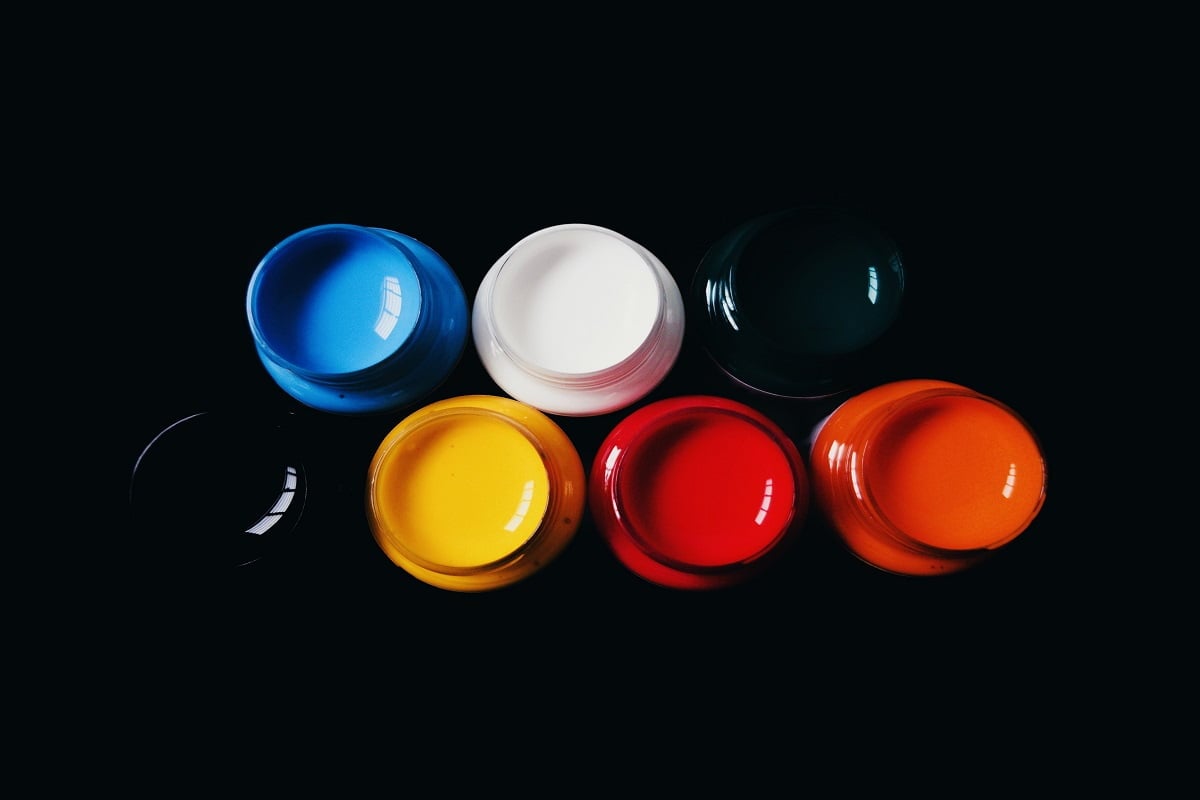When you have spare paint cans or bottles lying around the house, it is important to know whether they are inflammable.

Some paints may seem completely harmless until the time you realize that they are not. That’s because they may contain elements that make them combustible, thereby posing a threat to your safety. But does that mean you stop using them? Not at all!
What you need is the right kind of knowledge that helps you understand which paints are inflammable and which are not. With a good understanding, you will be able to use and store them safely. And once you take proper precautions, there’s nothing to worry about.
The enthusiasm to learn more about paints must have brought you here, and you are at the right place. In this guide, we discuss the major types of paints and their characteristics. This will help you understand them better and enable you to use them more efficiently.
So, without any more delay, let’s dive right in!
What’s Flammable And What’s Not?

Truth be told, there is no one answer to this question. Almost all paints are different from each other and they exhibit different characteristics. Whether a paint is flammable or not is determined by the kind of solvent that is present in it. The solvent holds the various ingredients in the paint together and helps in delivering the color and texture.
Paints that are flammable contain a good amount of solvent that gets transferred to the walls after you are done painting. And once the painting is over, you can smell the solvent evaporating from the walls. This is when you need good ventilation to ensure that you do not breathe in any harmful chemicals.
If you end up in a windowless room for hours right after it has been painted, there’s a high chance that you will inhale toxic chemicals. And that can cause serious damage to your lungs.
In case you have any difficulty in understanding if a paint is flammable or not, there’s a small trick that can help. Always remember that water-based paints are not inflammable and are completely safe for use.
On the other hand, aerosol paints come with propellant pressurized cans that enable you to deliver an even layer of paint. However, it is this feature that makes them inflammable. So, you must take proper care when working with one.
Are Acrylic Paints Flammable?
Acrylic paints are completely water-based, so there’s no chance that they will be inflammable. They usually don’t contain any trace of flammable oils in it, and the water content acts as an emulsifier.
When you are using acrylic colors that are water-based, you can easily wash them with soap. This makes maintenance pretty easy and does not require you to come in contact with toxic elements. And when you are using acrylic paints, there is no need for a thinner, which can be quite inflammable.
However, this in no way means that it is safe to put acrylic colors on your body or put them in your mouth. In case you accidentally put some on yourself, try to remove it immediately.
Actually, acrylic colors are pretty non-toxic when used on regular surfaces. Each brand has a different drying time, and you would get all the details printed on the instruction manual. On average, it does not take more than a day’s time for acrylic paints to dry.
That said, we’d still suggest that you use acrylic paints in well-ventilated space. This is because the other chemicals present in it might make you feel suffocated.
Are Spray Paints Flammable?
Spray paint is highly flammable, and you must take proper care when handling it. Just like soda is pressurized in the can, so are spray paints. They are highly pressurized and contain a good amount of butane and propane gasses. These two elements work as propellants.
You might be wondering why to use a propellant in a spray can? Well, it is the gasses and the pressure that help the color come out of the can with much ease. The moment you press on the nozzle, the pressure gets released, and the paint gets pushed to the bottom of the spray can.
Once the pressure is put on the valve, it reaches the end of the can and enters the dip tube, and comes right out of it. This way, the paint comes out of the nozzle, and there’s some amount of propellant in it too. And this is what makes the spray color pretty flammable.
At other times, the paint comes out of the can in the form of a uniform mist. Propellants contain particles that repel each other, which means that the longer they stay, the further the mist will be repelled.
Make sure that you apply the paint in a way that the repelling is uniform for the color to get used properly. The further the nozzle is placed from the canvas, the better will be the application and the spread. And ensure that you take proper care to not puncture the can, as that would release all the pressure at one go. This will make all the contents come out at once.
Are Oil-Based Paints Flammable?
Oils are flammable, and so are oil-based paints. They catch fire easily because of the solvents present in them. A lot of users choose to use latex paints instead. But, there are indeed many users who still prefer to use oil-based paints. However, more and more people are getting inclined towards using latex paints today.
People are looking for other alternatives because of the restrictions that many states place on the use of oil-based paints. Because of the limits, getting hold of these paints and their disposal both become pretty challenging. Other than that, most oil-based paints have chemical solvents that give rise to volatile gases.
As a result, some states do not allow users to dispose of oil-based paints in toilets and drainage. Without proper measures, they can create quite some trouble in the water treatment plants. Paint thinners also need to be carefully disposed of as they might give rise to a fire if not handled properly.
However, this is not the case in every country, and there are many places where painters choose to use oil-based colors. If you are planning to do the same, we only recommend that you handle it with care. When you do that, the risks become considerably less.
Are Latex Paints Flammable?
Latex paints, like acrylic, are composed of water-based components and acrylic polymer, which makes them entirely non-flammable. Apart from the polymer microparticles that are used as binders in both types, there’s hardly any difference between the two.
As we have mentioned in the previous section, a lot of people are selecting latex as a better alternative to oil-based paints. So, you will get to see many people opting for it to color their indoor and outdoor walls. The shift in preference seems justified as latex paints are not at all harmful to the skin because there are no toxic elements in them.
Latex paints that you use today are made of synthetic resins, which do not easily expand or contract as oil paint does. Even if you come in contact with them, they are not harmful and can be easily washed off. But make sure that you do not ingest them or purposely paint your body with one.
The other advantage is that latex paints are porous in nature and as a result, they don’t not trap moisture. However, ensure that you give the primer some time to dry off before putting in the latex paint. Otherwise, the final output will not be nice.
Paint Safety Recommendations
It is not like flammable paints cannot be worked with. However, you need to know the correct ways of handling them. Be it flammable or non-flammable color; you need to know how to use them well.
Efficient Storage
Make sure that you store the paints well to ensure that they do not cause any problem. And while storing them, remember to not put the flammable variants near a heat source. Even a tiny mistake can lead to big troubles in situations like this.
Apart from that, remember to not smoke near the paint and maintain the highest amount of safety. Consider keeping a fire extinguisher nearby. If you store the pigments well, their chances of catching fire are significantly less. So, try to keep them away from kids and pets and try disposing of them at a toxic dumping site if they are flammable.
Effective Ventilation
To prevent fire or uneasiness caused by toxic chemicals in paints, it is essential that you work in areas that are well-ventilated. We understand that it is not always possible to set up an outdoor workshop. In that case, try to work near the windows and keep them open. If you still feel a little stuffy, it is best to install a fan in the room to improve air circulation.
Proper Cleaning
As we have mentioned before, there are many paints that contain toxic substances. So, it is best to clean the work area and yourself after you are done working for the day. Any uncleaned trace may cause a lot of damage.
Also, do not forget to clean the ladders, cleaning cloths, and tools in your workshop.

Final Words
With that, it’s a wrap for today.
We hope that you had a great time learning about the different types of paints and understanding how to handle them best. One must pay good attention to paint quality, but that does not mean that there is no need to neglect your safety.
All paints are different and exhibit different characteristics. And before you start working with them, it is essential that you know whether they are inflammable or not. In case they are, you can take the necessary measures to stay safe. With good knowledge about paints, it will get easier for you to use them without any hassle.
If you have any further queries, feel free to reach out to us in the comments section below. And for more exciting reads, keep a watch on this space.
Until next time, fare thee well!
Related Articles
9 Best Paint Primer For Drywall Tested
9 Best Paint Brush For Polyurethane
5 of The Best Paint for Canvas Today
7 Best Cold Galvanizing Paints
How to Remove Spray Paint from Concrete
7 Best Primers For Covering Red Paint
